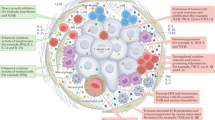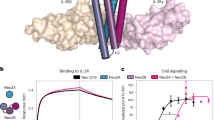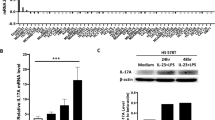Abstract
It has been shown that intratumor administration of an adenovirus vector expressing IL-12 produces a potent T cell-mediated response that leads to significant tumor regression in a murine breast cancer model. IP-10 and MIG are CXC chemokines that recruit mononuclear cells in vivo. In addition to their chemotactic roles, IP-10 and MIG inhibit angiogenesis. We tested whether the addition of IP-10 or MIG may both enhance the antitumor immune response of IL-12 through T cell recruitment and inhibit tumor growth through angiostasis. Adenovirus vectors expressing IP-10 or MIG and/or IL-12 were administered intratumorally in a murine model of mammary adenocarcinoma and fibrosarcoma. Administration of IP-10 or MIG in combination with IL-12 resulted in considerable tumor regression and increased survival time of tumor-bearing animals as compared with IP-10, MIG, IL-12 alone or control-treated animals, with the IP-10 IL-12 combination being most effective. These results suggest augmenting the antitumor immune response and inhibiting tumor angiogenesis with adenoviral vectors expressing IP-10 in combination with IL-12 is a novel way to enhance tumor regression.
This is a preview of subscription content, access via your institution
Access options
Subscribe to this journal
Receive 12 print issues and online access
$259.00 per year
only $21.58 per issue
Buy this article
- Purchase on Springer Link
- Instant access to full article PDF
Prices may be subject to local taxes which are calculated during checkout





Similar content being viewed by others
References
Addison CL et al. Intratumoral coinjection of adenoviral vectors expressing IL-2 and Il-12 results in enhanced frequency of regression of injected and untreated distal tumors Gene Therapy 1998 5: 1400–1409
Bramson JL et al. Direct intratumoral injection of an adenovirus expressing interleukin-12 induces regression and long-lasting immunity that is associated with highly localized expression of Interleukin-12 Hum Gene Ther 1996 7: 1995–2002
Putzer BM et al. Interleukin-12 and B7-1 costimulatory molecule expressed by an adenovirus vector act synergistically to facilitate tumor regression Proc Natl Acad Sci USA 1997 94: 10889–10894
Burke F . Cytokines (IFNs, TNF-alpha, IL-2 and IL-12) and animal models of cancer Cytokines Cell Mol Ther 1999 5: 51–61
Schlom J, Hodge JW . The diversity of T-cell co-stimulation in the induction of antitumor immunity Immunol Rev 1999 170: 73–84
Brunda MJ et al. Antitumor and antimetastatic activity of interleukin 12 against murine tumors J Exp Med 1993 178: 1223–1230
Trinchieri G . Interleukin-12: a cytokine at the interface of inflammation and immunity Adv Immunol 1998 70: 83–243
Brunda MJ et al. Role of interferon-gamma in mediating the antitumor efficacy of interleukin-12 J Immunother Emphasis Tumor Immunol 1995 17: 71–77
Luster AD, Unkeless JC, Ravetch JV . γ-Interferon transcriptionally regulates an early-reponse gene containing homology to platelet proteins Nature 1985 315: 672–676
Liao F . Human Mig chemokine: biochemical and functional characterization J Exp Med 1995 182: 1301–1314
Dewald B . IP-10, a gamma-interferon-inducible protein related to interleukin-8, lacks neutrophil activating properties Immunol Lett 1992 32: 81–84
Loetscher M et al. Chemokine receptor specific for IP10 and mig: structure, function, and expression in activated T-lymphocytes J Exp Med 1996 184: 963–969
Taub DD, Sayers TJ, Carter CRD, Ortaldo JR . α and β chemokines induce NK cell migration and enhance NK cell cytolytic activity via cellular degradation J Immunol 1995 156: 322–327
Taub DD et al. Recombinant human interferon-inducible protein 10 is a chemoattractant for human monocytes and T lymphocytes and promotes T cell adhesion to endothelial cells J Exp Med 1993 177: 1809–1814
Maghazachi AA, Skalhegg BS, Rolstad B, Al-Aoukaty A . Interferon-inducible protein-10 and lymphotactin induce the chemotaxis and mobilization of intracellular calcium in natural killer cells through pertussis toxin-sensitive and -insensitive heterotrimeric G-proteins FASEB J 1997 11: 765–774
Angiolillo AL et al. Human interferon-inducible protein 10 is a potent inhibitor of angiogenesis in vivo J Exp Med 1995 182: 155–162
Arenberg DA et al. Interferon-gamma-inducible protein 10 (IP-10) is an angiostatic factor that inhibits human non-small cell lung cancer (NSCLC) tumorigenesis and spontaneous metastases J Exp Med 1996 184: 981–992
Sgadari C et al. Interferon-inducible protein-10 identified as a mediator of tumor necrosis in vivo Proc Natl Acad Sci USA 1996 93: 13791–13796
Sgadari C et al. Mig, the monokine induced by interferon-gamma, promotes tumor necrosis in vivo Blood 1997 89: 2635–2643
Farber JM . Mig and IP-10: CXC chemokines that target lymphocytes J Leuk Biol 1997 61: 246–257
Tannebaum CS et al. The CXC chemokines IP-10 and Mig are necessary for IL-12 mediated regression of mouse RENCA tumor J Immunol 1998 161: 927–932
Car BD, Eng VM, Lipman JM, Anderson TD . The toxicology of interleukin-12: a review Toxicol Pathol 1999 27: 58–63
Palmer K, Emtage PC, Strieter RM, Gauldie J . Transient gene transfer of non-ELR chemokines to rodent lung induces mononuclear cell accumulation and activation J Interferon Cytokine Res 1999 19: 1381–1390
Guy CT, Cardiff RD, Muller WJ . Induction of mammary tumors by expression of polymona middle T oncogene: a transgenic model for metastatic disease Mol Cell Biol 1992 12: 954–961
Addison CL et al. Intratumoral injection of an adenovirus expressing interleukin 2 induces regression and immunity in a murine breast cancer model Proc Natl Acad Sci USA 1995 92: 8522–8526
Emtage PC et al. Adenoviral vectors expressing lymphotactin and interleukin 2 or lymphotactin and interleukin 12 synergize to facilitate tumor regression in murine breast cancer models Hum Gene Ther 1999 10: 697–709
Kelner GS et al. Lymphotactin: a cytokine that represents a new class of chemokine Science 1994 266: 1395–1399
Biacnchi G et al. Migratory response of human natural killer cells to lymphotactin Eur J Immunol 1996 26: 3238–3241
Taub DD, Longo DL, Murphy WJ . Human interferon-inducible protein-10 induces mononuclear cell infiltration in mice and promotes the migration of human T lymphocytes into the peripheral tissues and human peripheral blood lymphocytes-SCID mice Blood 1996 87: 1423–1431
Hung K et al. The central role of CD4+ T cells in the antitumor immune response J Exp Med 1998 188: 2357–2368
Loetscher P et al. CCR5 is characteristic of Th1 lymphocytes Nature 1998 391: 344–345
Bonecchi R et al. Differential expression of chemokine receptors and chemotactic responsiveness of type 1 T helper cells (Th1s) and Th2s J Exp Med 1998 187: 129–134
Ogawa M et al. Multiple roles of interferon-gamma in the mediation of interleukin 12-induced tumor regression Cancer Res 1998 58: 2426–2432
Voest E et al. Inhibition of angiogenesis in vivo by interleukin 12 J Natl Cancer Inst 1995 87: 581–586
Coughlin CM et al. Tumor cell responses to IFNgamma affect tumorigenicity and response to IL-12 therapy and antiangiogenesis Immunity 1998 9: 25–34
Sgadari C, Angiolillo AL, Tosato G . Inhibition of angiogenesis by interleukin-12 is mediated by the interferon-inducible protein 10 Blood 1996 87: 3877–3882
Strieter RM et al. Interferon gamma-inducible protein 10 (IP-10), a member of the C-X-C chemokine family, is an inhibitor of angiogenesis Biochem Biophys Res Commun 1995 210: 51–57
Kanegane C et al. Contribution of the CXC chemokines IP-10 and MIG to the antitumor effects of IL-12 J Leuk Biol 1998 64: 384–392
Melcher A et al. Tumor immunogenicity is determined by the mechanism of cell death via induction of heat shock protein expression Nature Med 1998 4: 581–587
Melcher A, Gough M, Todryk S, Vile R . Apoptosis or necrosis for tumor immunotherapy: what's in a name J Mol Med 1999 12: 824–833
Acknowledgements
We acknowledge the excellent technical help of Duncan Chong and Xueya Feng. This work is funded by the Medical Research Council (Canada).
Author information
Authors and Affiliations
Rights and permissions
About this article
Cite this article
Palmer, K., Hitt, M., Emtage, P. et al. Combined CXC chemokine and interleukin-12 gene transfer enhances antitumor immunity. Gene Ther 8, 282–290 (2001). https://doi.org/10.1038/sj.gt.3301386
Received:
Accepted:
Published:
Issue Date:
DOI: https://doi.org/10.1038/sj.gt.3301386
Keywords
This article is cited by
-
New insights into IL-12-mediated tumor suppression
Cell Death & Differentiation (2015)
-
Interleukin 12: still a promising candidate for tumor immunotherapy?
Cancer Immunology, Immunotherapy (2014)
-
Ultrasound-guided intra-tumor injection of combined immunotherapy cures mice from orthotopic prostate cancer
Cancer Immunology, Immunotherapy (2013)
-
The role of CXC chemokines and their receptors in the progression and treatment of tumors
Journal of Molecular Histology (2012)
-
Treatment combining RU486 and Ad5IL-12 vector attenuates the growth of experimentally formed prostate tumors and induces changes in the sentinel lymph nodes of mice
Journal of Translational Medicine (2010)



